Business Law Report
VerifiedAdded on 2020/02/05
|14
|4159
|49
Report
AI Summary
This report addresses a business law case involving the sale of a defective used car. It analyzes the legal rules of implied terms in the sale of goods, statutory provisions on transferring property and possession, buyer's and seller's remedies, and product liability. The report also examines types of consumer credit, termination rights and notices, features of agency, and the rights and duties of parties involved. Finally, an essay discusses different forms of intellectual property rights, including patents, copyrights, and trademarks, and the legal rules preventing their infringement. The report uses UK law as its framework, referencing relevant acts and case law to support its analysis.
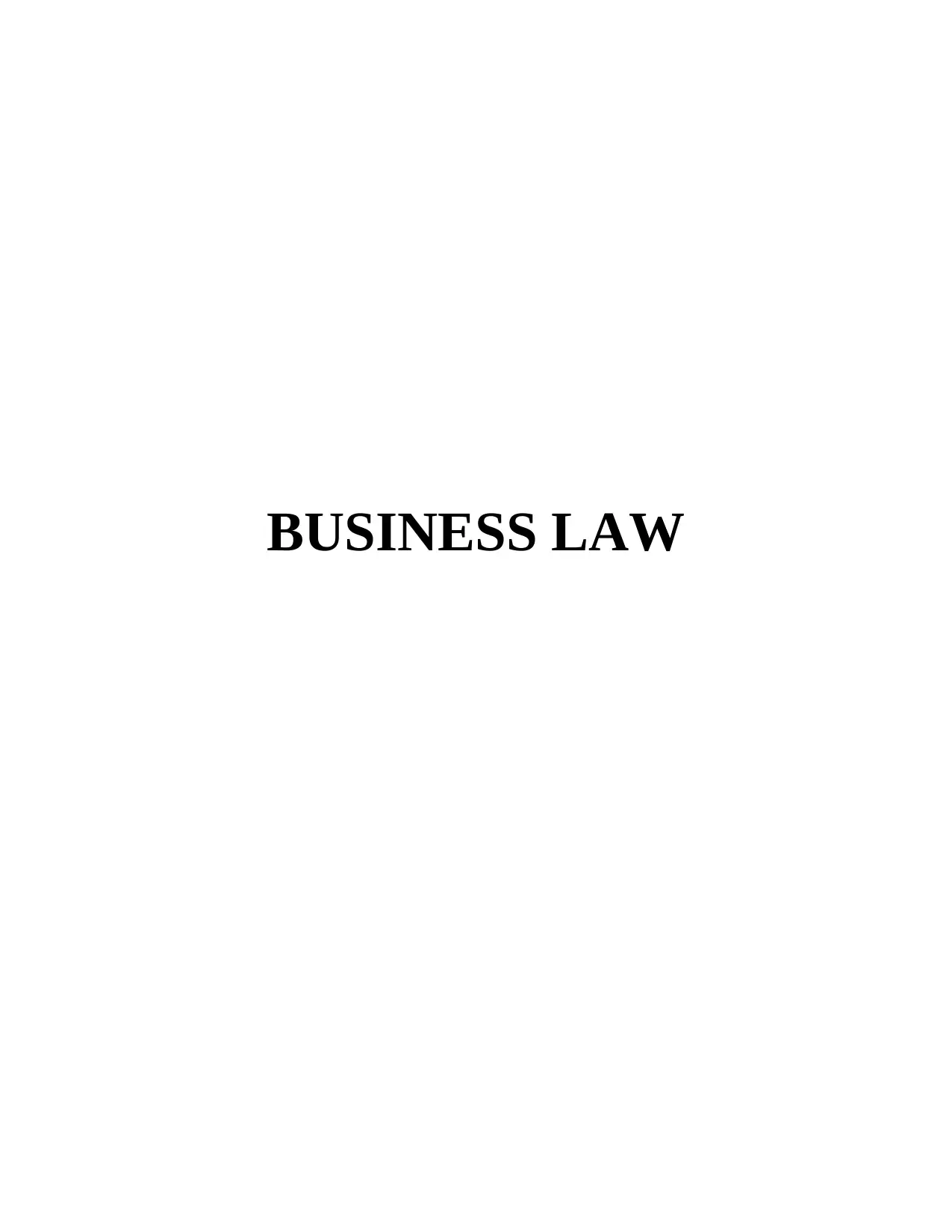
BUSINESS LAW
Paraphrase This Document
Need a fresh take? Get an instant paraphrase of this document with our AI Paraphraser
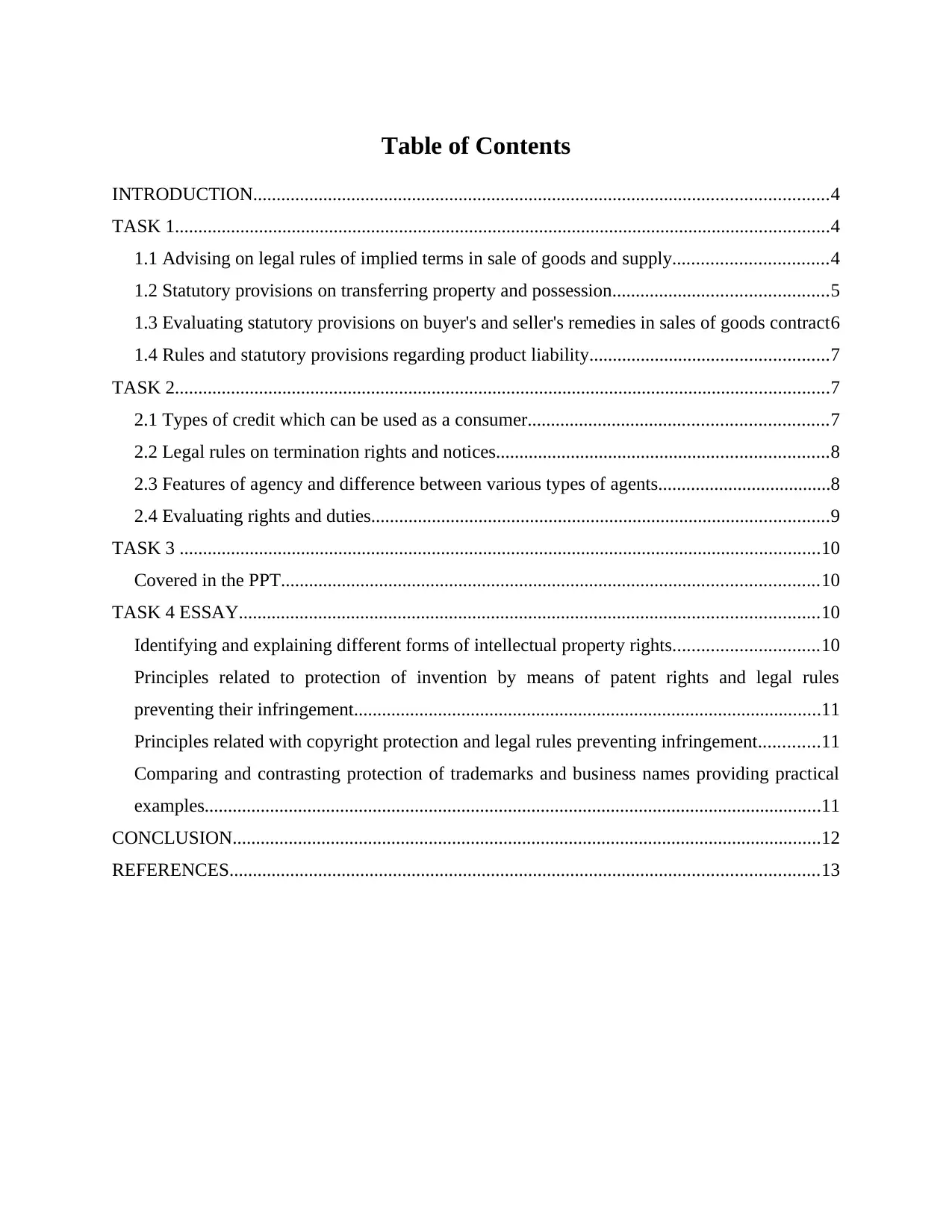
Table of Contents
INTRODUCTION...........................................................................................................................4
TASK 1............................................................................................................................................4
1.1 Advising on legal rules of implied terms in sale of goods and supply.................................4
1.2 Statutory provisions on transferring property and possession..............................................5
1.3 Evaluating statutory provisions on buyer's and seller's remedies in sales of goods contract6
1.4 Rules and statutory provisions regarding product liability...................................................7
TASK 2............................................................................................................................................7
2.1 Types of credit which can be used as a consumer................................................................7
2.2 Legal rules on termination rights and notices.......................................................................8
2.3 Features of agency and difference between various types of agents.....................................8
2.4 Evaluating rights and duties..................................................................................................9
TASK 3 .........................................................................................................................................10
Covered in the PPT...................................................................................................................10
TASK 4 ESSAY............................................................................................................................10
Identifying and explaining different forms of intellectual property rights...............................10
Principles related to protection of invention by means of patent rights and legal rules
preventing their infringement....................................................................................................11
Principles related with copyright protection and legal rules preventing infringement.............11
Comparing and contrasting protection of trademarks and business names providing practical
examples....................................................................................................................................11
CONCLUSION..............................................................................................................................12
REFERENCES..............................................................................................................................13
INTRODUCTION...........................................................................................................................4
TASK 1............................................................................................................................................4
1.1 Advising on legal rules of implied terms in sale of goods and supply.................................4
1.2 Statutory provisions on transferring property and possession..............................................5
1.3 Evaluating statutory provisions on buyer's and seller's remedies in sales of goods contract6
1.4 Rules and statutory provisions regarding product liability...................................................7
TASK 2............................................................................................................................................7
2.1 Types of credit which can be used as a consumer................................................................7
2.2 Legal rules on termination rights and notices.......................................................................8
2.3 Features of agency and difference between various types of agents.....................................8
2.4 Evaluating rights and duties..................................................................................................9
TASK 3 .........................................................................................................................................10
Covered in the PPT...................................................................................................................10
TASK 4 ESSAY............................................................................................................................10
Identifying and explaining different forms of intellectual property rights...............................10
Principles related to protection of invention by means of patent rights and legal rules
preventing their infringement....................................................................................................11
Principles related with copyright protection and legal rules preventing infringement.............11
Comparing and contrasting protection of trademarks and business names providing practical
examples....................................................................................................................................11
CONCLUSION..............................................................................................................................12
REFERENCES..............................................................................................................................13

⊘ This is a preview!⊘
Do you want full access?
Subscribe today to unlock all pages.

Trusted by 1+ million students worldwide
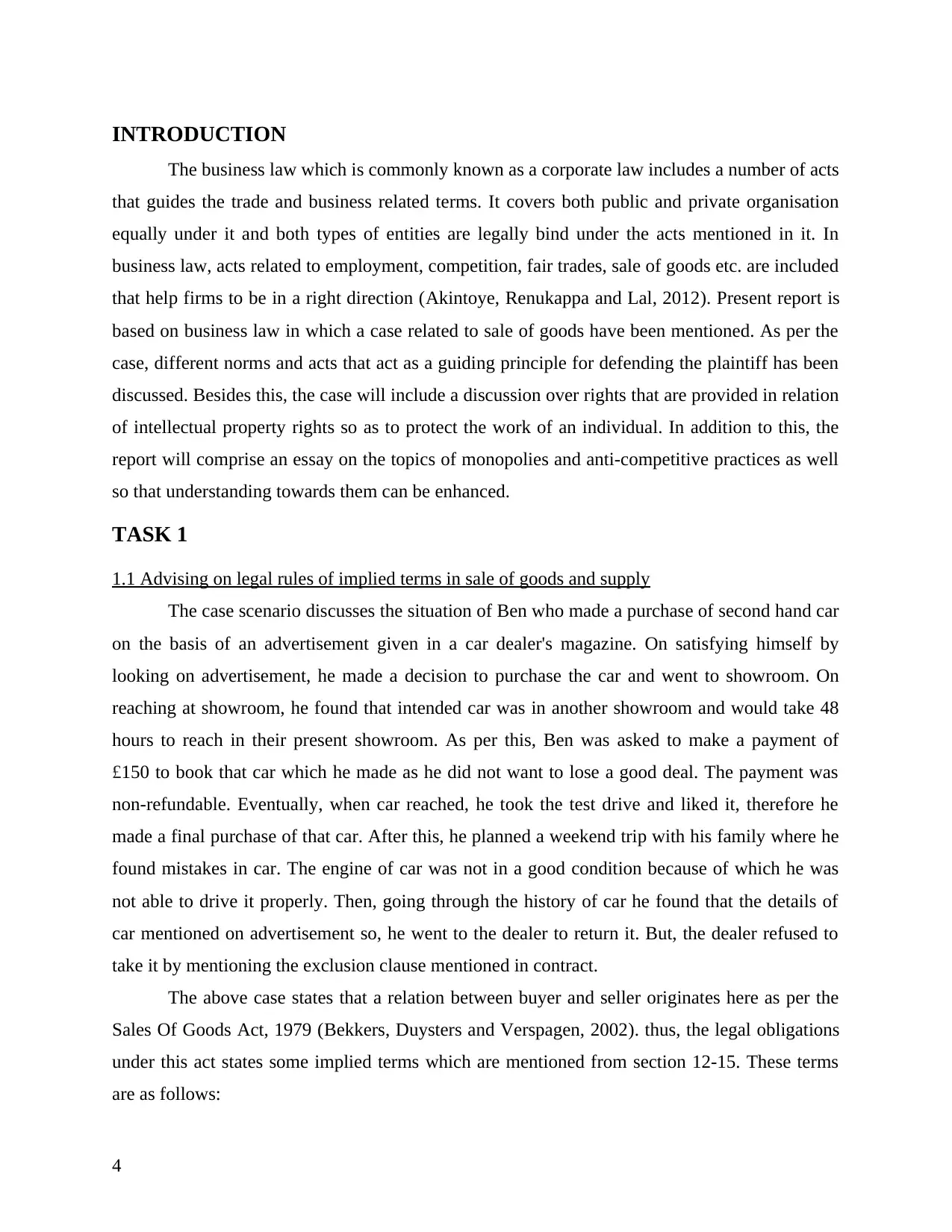
INTRODUCTION
The business law which is commonly known as a corporate law includes a number of acts
that guides the trade and business related terms. It covers both public and private organisation
equally under it and both types of entities are legally bind under the acts mentioned in it. In
business law, acts related to employment, competition, fair trades, sale of goods etc. are included
that help firms to be in a right direction (Akintoye, Renukappa and Lal, 2012). Present report is
based on business law in which a case related to sale of goods have been mentioned. As per the
case, different norms and acts that act as a guiding principle for defending the plaintiff has been
discussed. Besides this, the case will include a discussion over rights that are provided in relation
of intellectual property rights so as to protect the work of an individual. In addition to this, the
report will comprise an essay on the topics of monopolies and anti-competitive practices as well
so that understanding towards them can be enhanced.
TASK 1
1.1 Advising on legal rules of implied terms in sale of goods and supply
The case scenario discusses the situation of Ben who made a purchase of second hand car
on the basis of an advertisement given in a car dealer's magazine. On satisfying himself by
looking on advertisement, he made a decision to purchase the car and went to showroom. On
reaching at showroom, he found that intended car was in another showroom and would take 48
hours to reach in their present showroom. As per this, Ben was asked to make a payment of
£150 to book that car which he made as he did not want to lose a good deal. The payment was
non-refundable. Eventually, when car reached, he took the test drive and liked it, therefore he
made a final purchase of that car. After this, he planned a weekend trip with his family where he
found mistakes in car. The engine of car was not in a good condition because of which he was
not able to drive it properly. Then, going through the history of car he found that the details of
car mentioned on advertisement so, he went to the dealer to return it. But, the dealer refused to
take it by mentioning the exclusion clause mentioned in contract.
The above case states that a relation between buyer and seller originates here as per the
Sales Of Goods Act, 1979 (Bekkers, Duysters and Verspagen, 2002). thus, the legal obligations
under this act states some implied terms which are mentioned from section 12-15. These terms
are as follows:
4
The business law which is commonly known as a corporate law includes a number of acts
that guides the trade and business related terms. It covers both public and private organisation
equally under it and both types of entities are legally bind under the acts mentioned in it. In
business law, acts related to employment, competition, fair trades, sale of goods etc. are included
that help firms to be in a right direction (Akintoye, Renukappa and Lal, 2012). Present report is
based on business law in which a case related to sale of goods have been mentioned. As per the
case, different norms and acts that act as a guiding principle for defending the plaintiff has been
discussed. Besides this, the case will include a discussion over rights that are provided in relation
of intellectual property rights so as to protect the work of an individual. In addition to this, the
report will comprise an essay on the topics of monopolies and anti-competitive practices as well
so that understanding towards them can be enhanced.
TASK 1
1.1 Advising on legal rules of implied terms in sale of goods and supply
The case scenario discusses the situation of Ben who made a purchase of second hand car
on the basis of an advertisement given in a car dealer's magazine. On satisfying himself by
looking on advertisement, he made a decision to purchase the car and went to showroom. On
reaching at showroom, he found that intended car was in another showroom and would take 48
hours to reach in their present showroom. As per this, Ben was asked to make a payment of
£150 to book that car which he made as he did not want to lose a good deal. The payment was
non-refundable. Eventually, when car reached, he took the test drive and liked it, therefore he
made a final purchase of that car. After this, he planned a weekend trip with his family where he
found mistakes in car. The engine of car was not in a good condition because of which he was
not able to drive it properly. Then, going through the history of car he found that the details of
car mentioned on advertisement so, he went to the dealer to return it. But, the dealer refused to
take it by mentioning the exclusion clause mentioned in contract.
The above case states that a relation between buyer and seller originates here as per the
Sales Of Goods Act, 1979 (Bekkers, Duysters and Verspagen, 2002). thus, the legal obligations
under this act states some implied terms which are mentioned from section 12-15. These terms
are as follows:
4
Paraphrase This Document
Need a fresh take? Get an instant paraphrase of this document with our AI Paraphraser
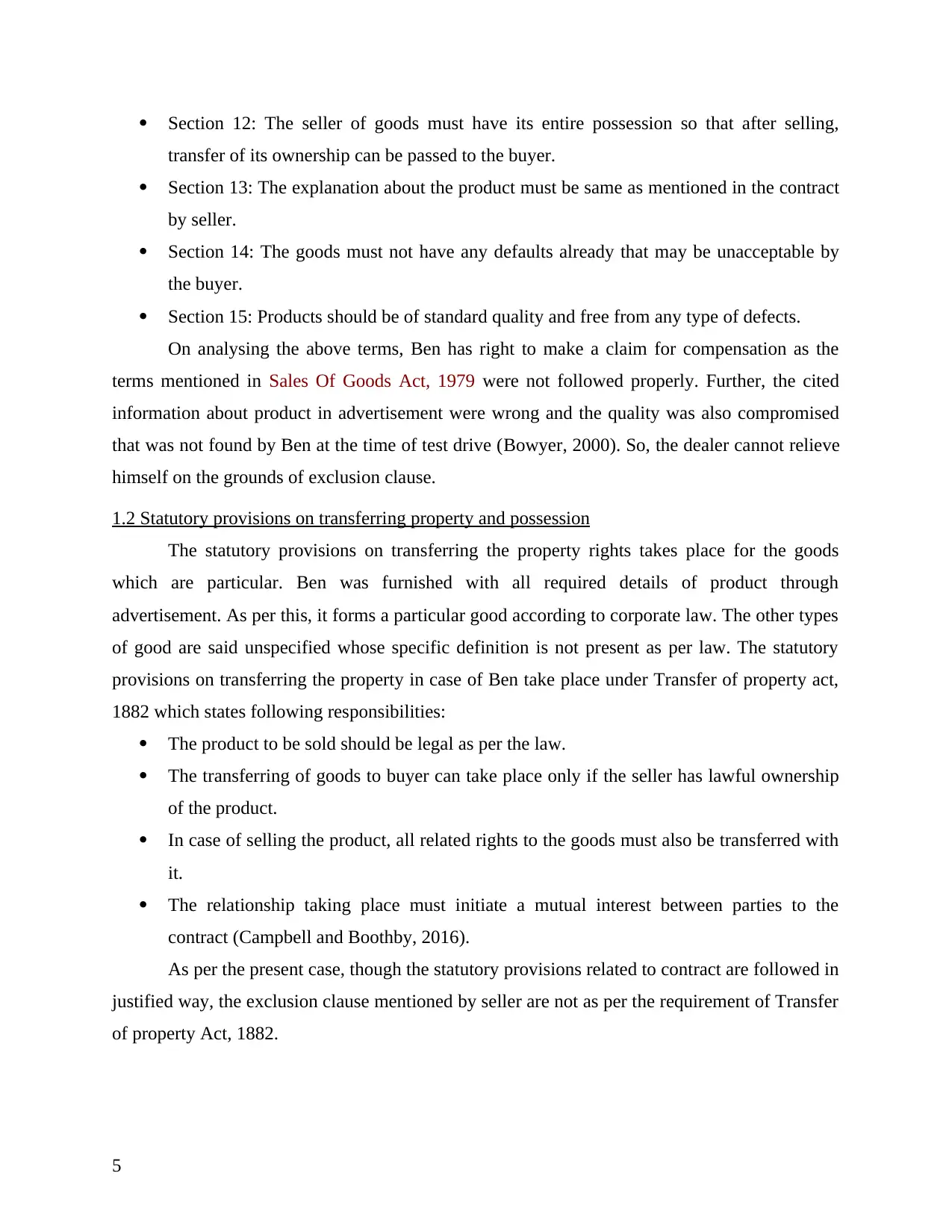
Section 12: The seller of goods must have its entire possession so that after selling,
transfer of its ownership can be passed to the buyer.
Section 13: The explanation about the product must be same as mentioned in the contract
by seller.
Section 14: The goods must not have any defaults already that may be unacceptable by
the buyer.
Section 15: Products should be of standard quality and free from any type of defects.
On analysing the above terms, Ben has right to make a claim for compensation as the
terms mentioned in Sales Of Goods Act, 1979 were not followed properly. Further, the cited
information about product in advertisement were wrong and the quality was also compromised
that was not found by Ben at the time of test drive (Bowyer, 2000). So, the dealer cannot relieve
himself on the grounds of exclusion clause.
1.2 Statutory provisions on transferring property and possession
The statutory provisions on transferring the property rights takes place for the goods
which are particular. Ben was furnished with all required details of product through
advertisement. As per this, it forms a particular good according to corporate law. The other types
of good are said unspecified whose specific definition is not present as per law. The statutory
provisions on transferring the property in case of Ben take place under Transfer of property act,
1882 which states following responsibilities:
The product to be sold should be legal as per the law.
The transferring of goods to buyer can take place only if the seller has lawful ownership
of the product.
In case of selling the product, all related rights to the goods must also be transferred with
it.
The relationship taking place must initiate a mutual interest between parties to the
contract (Campbell and Boothby, 2016).
As per the present case, though the statutory provisions related to contract are followed in
justified way, the exclusion clause mentioned by seller are not as per the requirement of Transfer
of property Act, 1882.
5
transfer of its ownership can be passed to the buyer.
Section 13: The explanation about the product must be same as mentioned in the contract
by seller.
Section 14: The goods must not have any defaults already that may be unacceptable by
the buyer.
Section 15: Products should be of standard quality and free from any type of defects.
On analysing the above terms, Ben has right to make a claim for compensation as the
terms mentioned in Sales Of Goods Act, 1979 were not followed properly. Further, the cited
information about product in advertisement were wrong and the quality was also compromised
that was not found by Ben at the time of test drive (Bowyer, 2000). So, the dealer cannot relieve
himself on the grounds of exclusion clause.
1.2 Statutory provisions on transferring property and possession
The statutory provisions on transferring the property rights takes place for the goods
which are particular. Ben was furnished with all required details of product through
advertisement. As per this, it forms a particular good according to corporate law. The other types
of good are said unspecified whose specific definition is not present as per law. The statutory
provisions on transferring the property in case of Ben take place under Transfer of property act,
1882 which states following responsibilities:
The product to be sold should be legal as per the law.
The transferring of goods to buyer can take place only if the seller has lawful ownership
of the product.
In case of selling the product, all related rights to the goods must also be transferred with
it.
The relationship taking place must initiate a mutual interest between parties to the
contract (Campbell and Boothby, 2016).
As per the present case, though the statutory provisions related to contract are followed in
justified way, the exclusion clause mentioned by seller are not as per the requirement of Transfer
of property Act, 1882.
5
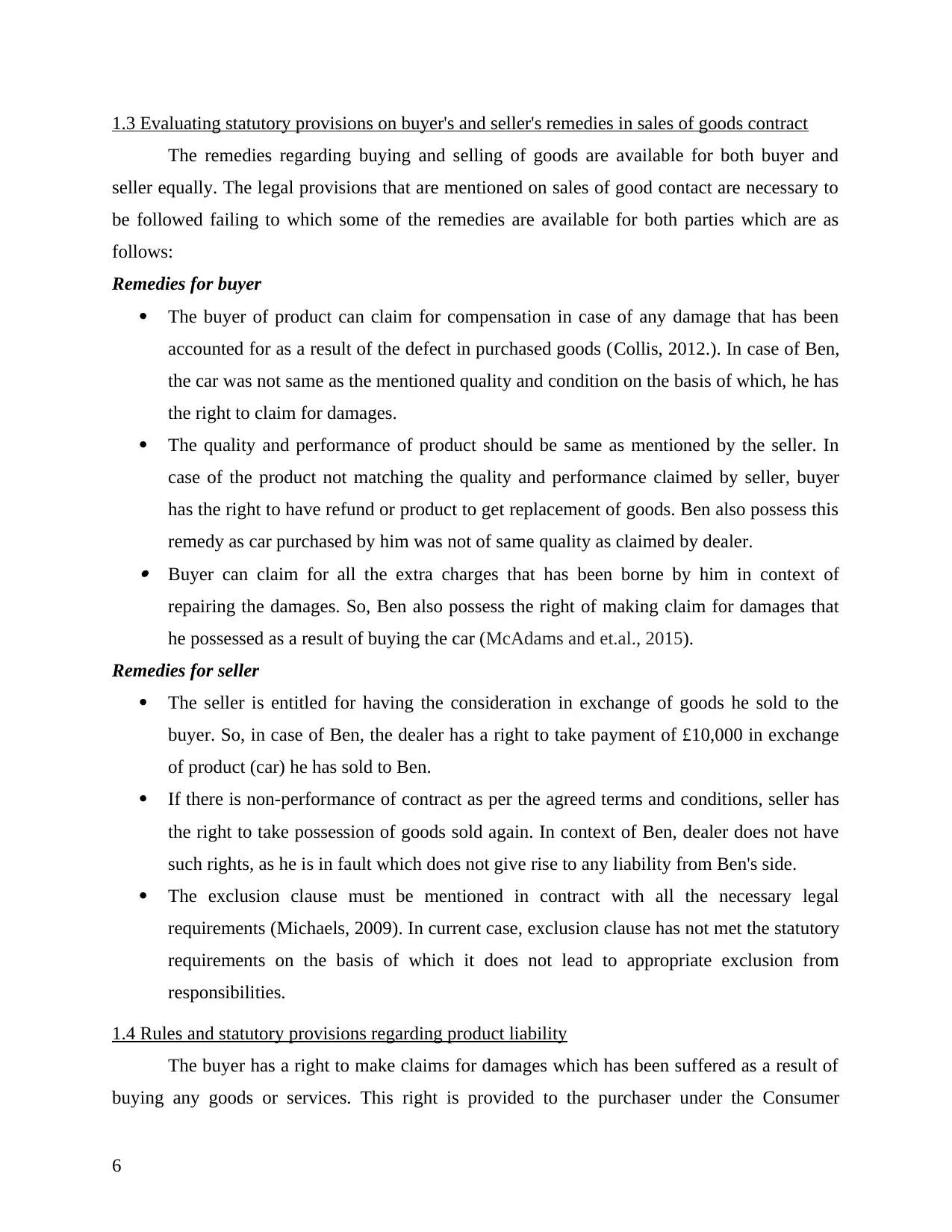
1.3 Evaluating statutory provisions on buyer's and seller's remedies in sales of goods contract
The remedies regarding buying and selling of goods are available for both buyer and
seller equally. The legal provisions that are mentioned on sales of good contact are necessary to
be followed failing to which some of the remedies are available for both parties which are as
follows:
Remedies for buyer
The buyer of product can claim for compensation in case of any damage that has been
accounted for as a result of the defect in purchased goods (Collis, 2012.). In case of Ben,
the car was not same as the mentioned quality and condition on the basis of which, he has
the right to claim for damages.
The quality and performance of product should be same as mentioned by the seller. In
case of the product not matching the quality and performance claimed by seller, buyer
has the right to have refund or product to get replacement of goods. Ben also possess this
remedy as car purchased by him was not of same quality as claimed by dealer. Buyer can claim for all the extra charges that has been borne by him in context of
repairing the damages. So, Ben also possess the right of making claim for damages that
he possessed as a result of buying the car (McAdams and et.al., 2015).
Remedies for seller
The seller is entitled for having the consideration in exchange of goods he sold to the
buyer. So, in case of Ben, the dealer has a right to take payment of £10,000 in exchange
of product (car) he has sold to Ben.
If there is non-performance of contract as per the agreed terms and conditions, seller has
the right to take possession of goods sold again. In context of Ben, dealer does not have
such rights, as he is in fault which does not give rise to any liability from Ben's side.
The exclusion clause must be mentioned in contract with all the necessary legal
requirements (Michaels, 2009). In current case, exclusion clause has not met the statutory
requirements on the basis of which it does not lead to appropriate exclusion from
responsibilities.
1.4 Rules and statutory provisions regarding product liability
The buyer has a right to make claims for damages which has been suffered as a result of
buying any goods or services. This right is provided to the purchaser under the Consumer
6
The remedies regarding buying and selling of goods are available for both buyer and
seller equally. The legal provisions that are mentioned on sales of good contact are necessary to
be followed failing to which some of the remedies are available for both parties which are as
follows:
Remedies for buyer
The buyer of product can claim for compensation in case of any damage that has been
accounted for as a result of the defect in purchased goods (Collis, 2012.). In case of Ben,
the car was not same as the mentioned quality and condition on the basis of which, he has
the right to claim for damages.
The quality and performance of product should be same as mentioned by the seller. In
case of the product not matching the quality and performance claimed by seller, buyer
has the right to have refund or product to get replacement of goods. Ben also possess this
remedy as car purchased by him was not of same quality as claimed by dealer. Buyer can claim for all the extra charges that has been borne by him in context of
repairing the damages. So, Ben also possess the right of making claim for damages that
he possessed as a result of buying the car (McAdams and et.al., 2015).
Remedies for seller
The seller is entitled for having the consideration in exchange of goods he sold to the
buyer. So, in case of Ben, the dealer has a right to take payment of £10,000 in exchange
of product (car) he has sold to Ben.
If there is non-performance of contract as per the agreed terms and conditions, seller has
the right to take possession of goods sold again. In context of Ben, dealer does not have
such rights, as he is in fault which does not give rise to any liability from Ben's side.
The exclusion clause must be mentioned in contract with all the necessary legal
requirements (Michaels, 2009). In current case, exclusion clause has not met the statutory
requirements on the basis of which it does not lead to appropriate exclusion from
responsibilities.
1.4 Rules and statutory provisions regarding product liability
The buyer has a right to make claims for damages which has been suffered as a result of
buying any goods or services. This right is provided to the purchaser under the Consumer
6
⊘ This is a preview!⊘
Do you want full access?
Subscribe today to unlock all pages.

Trusted by 1+ million students worldwide
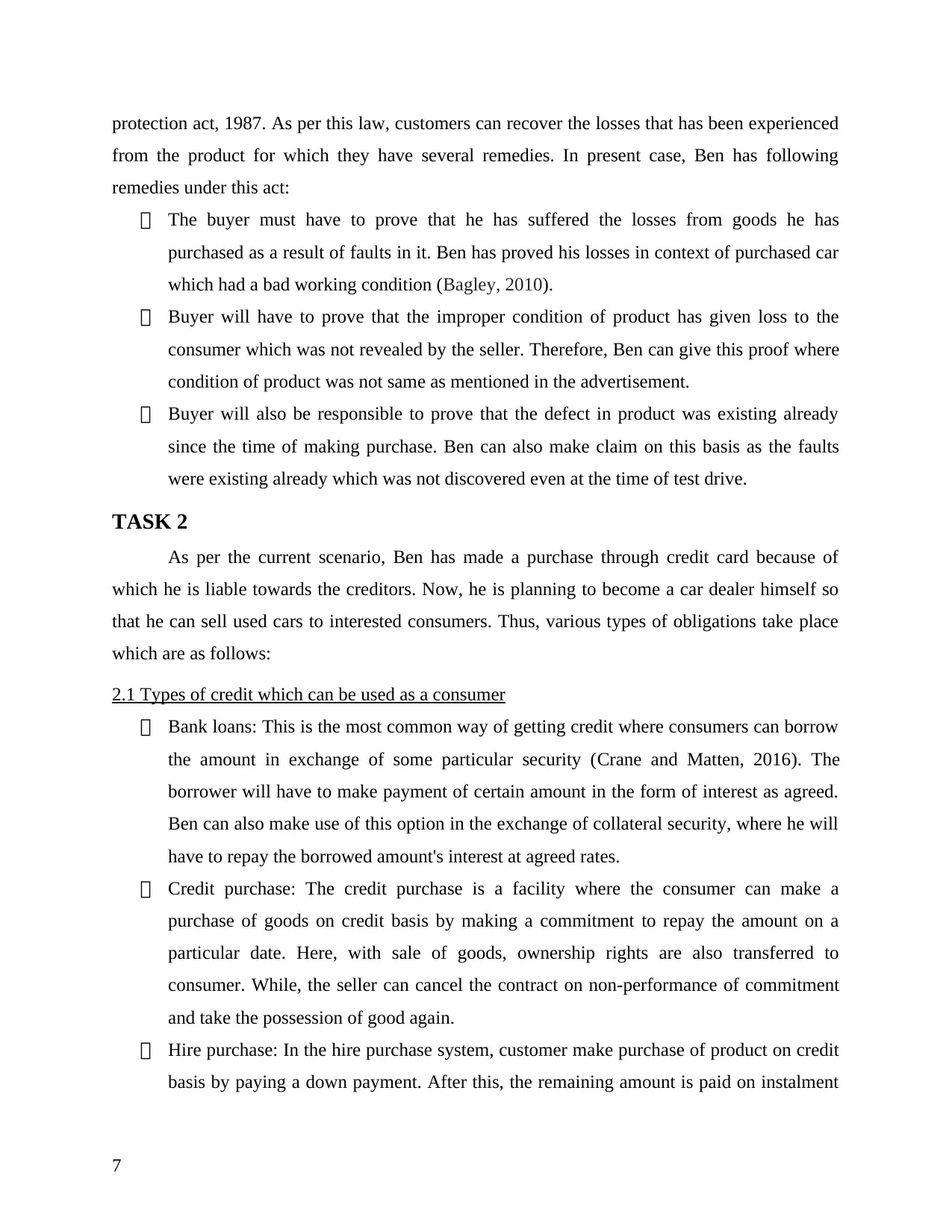
protection act, 1987. As per this law, customers can recover the losses that has been experienced
from the product for which they have several remedies. In present case, Ben has following
remedies under this act:
The buyer must have to prove that he has suffered the losses from goods he has
purchased as a result of faults in it. Ben has proved his losses in context of purchased car
which had a bad working condition (Bagley, 2010).
Buyer will have to prove that the improper condition of product has given loss to the
consumer which was not revealed by the seller. Therefore, Ben can give this proof where
condition of product was not same as mentioned in the advertisement.
Buyer will also be responsible to prove that the defect in product was existing already
since the time of making purchase. Ben can also make claim on this basis as the faults
were existing already which was not discovered even at the time of test drive.
TASK 2
As per the current scenario, Ben has made a purchase through credit card because of
which he is liable towards the creditors. Now, he is planning to become a car dealer himself so
that he can sell used cars to interested consumers. Thus, various types of obligations take place
which are as follows:
2.1 Types of credit which can be used as a consumer
Bank loans: This is the most common way of getting credit where consumers can borrow
the amount in exchange of some particular security (Crane and Matten, 2016). The
borrower will have to make payment of certain amount in the form of interest as agreed.
Ben can also make use of this option in the exchange of collateral security, where he will
have to repay the borrowed amount's interest at agreed rates.
Credit purchase: The credit purchase is a facility where the consumer can make a
purchase of goods on credit basis by making a commitment to repay the amount on a
particular date. Here, with sale of goods, ownership rights are also transferred to
consumer. While, the seller can cancel the contract on non-performance of commitment
and take the possession of good again.
Hire purchase: In the hire purchase system, customer make purchase of product on credit
basis by paying a down payment. After this, the remaining amount is paid on instalment
7
from the product for which they have several remedies. In present case, Ben has following
remedies under this act:
The buyer must have to prove that he has suffered the losses from goods he has
purchased as a result of faults in it. Ben has proved his losses in context of purchased car
which had a bad working condition (Bagley, 2010).
Buyer will have to prove that the improper condition of product has given loss to the
consumer which was not revealed by the seller. Therefore, Ben can give this proof where
condition of product was not same as mentioned in the advertisement.
Buyer will also be responsible to prove that the defect in product was existing already
since the time of making purchase. Ben can also make claim on this basis as the faults
were existing already which was not discovered even at the time of test drive.
TASK 2
As per the current scenario, Ben has made a purchase through credit card because of
which he is liable towards the creditors. Now, he is planning to become a car dealer himself so
that he can sell used cars to interested consumers. Thus, various types of obligations take place
which are as follows:
2.1 Types of credit which can be used as a consumer
Bank loans: This is the most common way of getting credit where consumers can borrow
the amount in exchange of some particular security (Crane and Matten, 2016). The
borrower will have to make payment of certain amount in the form of interest as agreed.
Ben can also make use of this option in the exchange of collateral security, where he will
have to repay the borrowed amount's interest at agreed rates.
Credit purchase: The credit purchase is a facility where the consumer can make a
purchase of goods on credit basis by making a commitment to repay the amount on a
particular date. Here, with sale of goods, ownership rights are also transferred to
consumer. While, the seller can cancel the contract on non-performance of commitment
and take the possession of good again.
Hire purchase: In the hire purchase system, customer make purchase of product on credit
basis by paying a down payment. After this, the remaining amount is paid on instalment
7
Paraphrase This Document
Need a fresh take? Get an instant paraphrase of this document with our AI Paraphraser
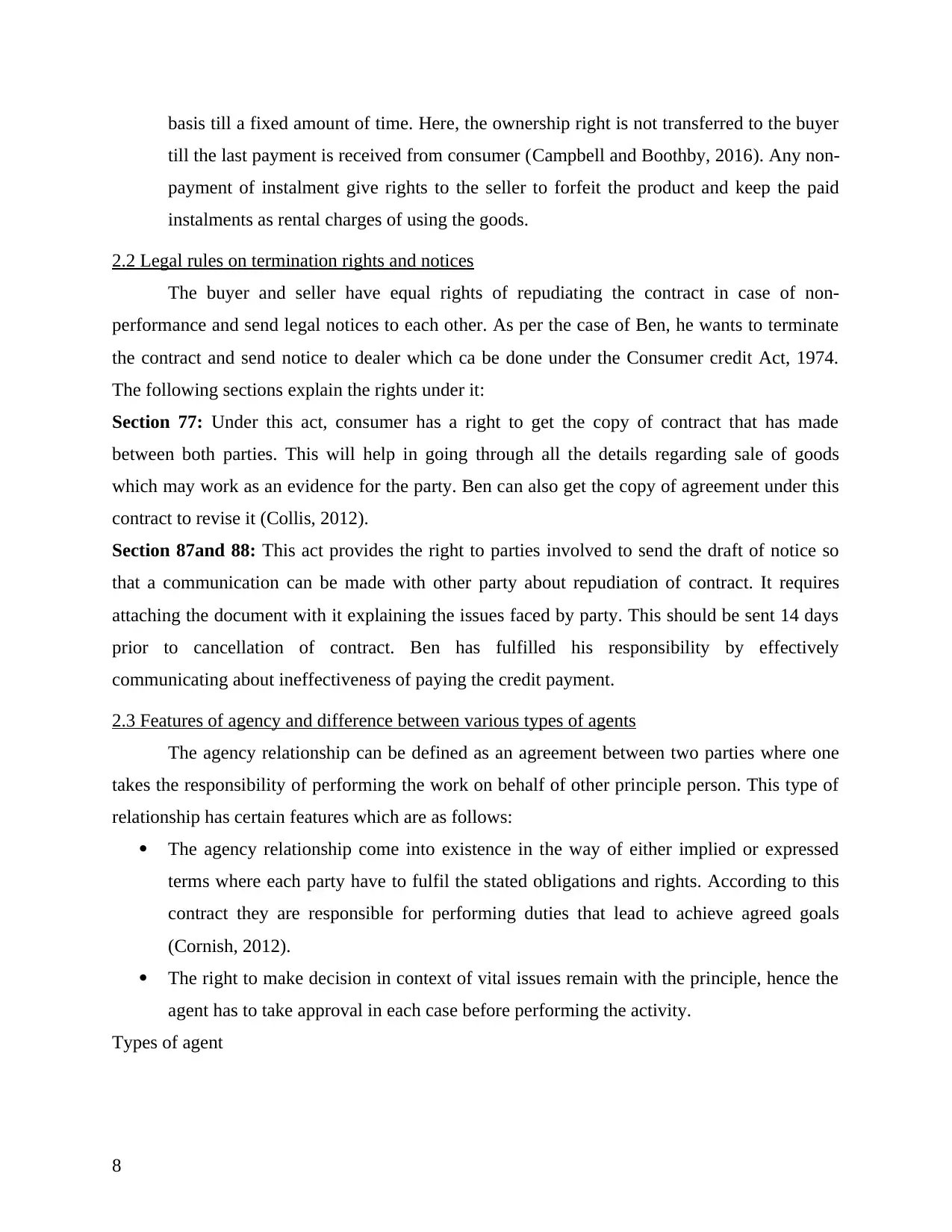
basis till a fixed amount of time. Here, the ownership right is not transferred to the buyer
till the last payment is received from consumer (Campbell and Boothby, 2016). Any non-
payment of instalment give rights to the seller to forfeit the product and keep the paid
instalments as rental charges of using the goods.
2.2 Legal rules on termination rights and notices
The buyer and seller have equal rights of repudiating the contract in case of non-
performance and send legal notices to each other. As per the case of Ben, he wants to terminate
the contract and send notice to dealer which ca be done under the Consumer credit Act, 1974.
The following sections explain the rights under it:
Section 77: Under this act, consumer has a right to get the copy of contract that has made
between both parties. This will help in going through all the details regarding sale of goods
which may work as an evidence for the party. Ben can also get the copy of agreement under this
contract to revise it (Collis, 2012).
Section 87and 88: This act provides the right to parties involved to send the draft of notice so
that a communication can be made with other party about repudiation of contract. It requires
attaching the document with it explaining the issues faced by party. This should be sent 14 days
prior to cancellation of contract. Ben has fulfilled his responsibility by effectively
communicating about ineffectiveness of paying the credit payment.
2.3 Features of agency and difference between various types of agents
The agency relationship can be defined as an agreement between two parties where one
takes the responsibility of performing the work on behalf of other principle person. This type of
relationship has certain features which are as follows:
The agency relationship come into existence in the way of either implied or expressed
terms where each party have to fulfil the stated obligations and rights. According to this
contract they are responsible for performing duties that lead to achieve agreed goals
(Cornish, 2012).
The right to make decision in context of vital issues remain with the principle, hence the
agent has to take approval in each case before performing the activity.
Types of agent
8
till the last payment is received from consumer (Campbell and Boothby, 2016). Any non-
payment of instalment give rights to the seller to forfeit the product and keep the paid
instalments as rental charges of using the goods.
2.2 Legal rules on termination rights and notices
The buyer and seller have equal rights of repudiating the contract in case of non-
performance and send legal notices to each other. As per the case of Ben, he wants to terminate
the contract and send notice to dealer which ca be done under the Consumer credit Act, 1974.
The following sections explain the rights under it:
Section 77: Under this act, consumer has a right to get the copy of contract that has made
between both parties. This will help in going through all the details regarding sale of goods
which may work as an evidence for the party. Ben can also get the copy of agreement under this
contract to revise it (Collis, 2012).
Section 87and 88: This act provides the right to parties involved to send the draft of notice so
that a communication can be made with other party about repudiation of contract. It requires
attaching the document with it explaining the issues faced by party. This should be sent 14 days
prior to cancellation of contract. Ben has fulfilled his responsibility by effectively
communicating about ineffectiveness of paying the credit payment.
2.3 Features of agency and difference between various types of agents
The agency relationship can be defined as an agreement between two parties where one
takes the responsibility of performing the work on behalf of other principle person. This type of
relationship has certain features which are as follows:
The agency relationship come into existence in the way of either implied or expressed
terms where each party have to fulfil the stated obligations and rights. According to this
contract they are responsible for performing duties that lead to achieve agreed goals
(Cornish, 2012).
The right to make decision in context of vital issues remain with the principle, hence the
agent has to take approval in each case before performing the activity.
Types of agent
8
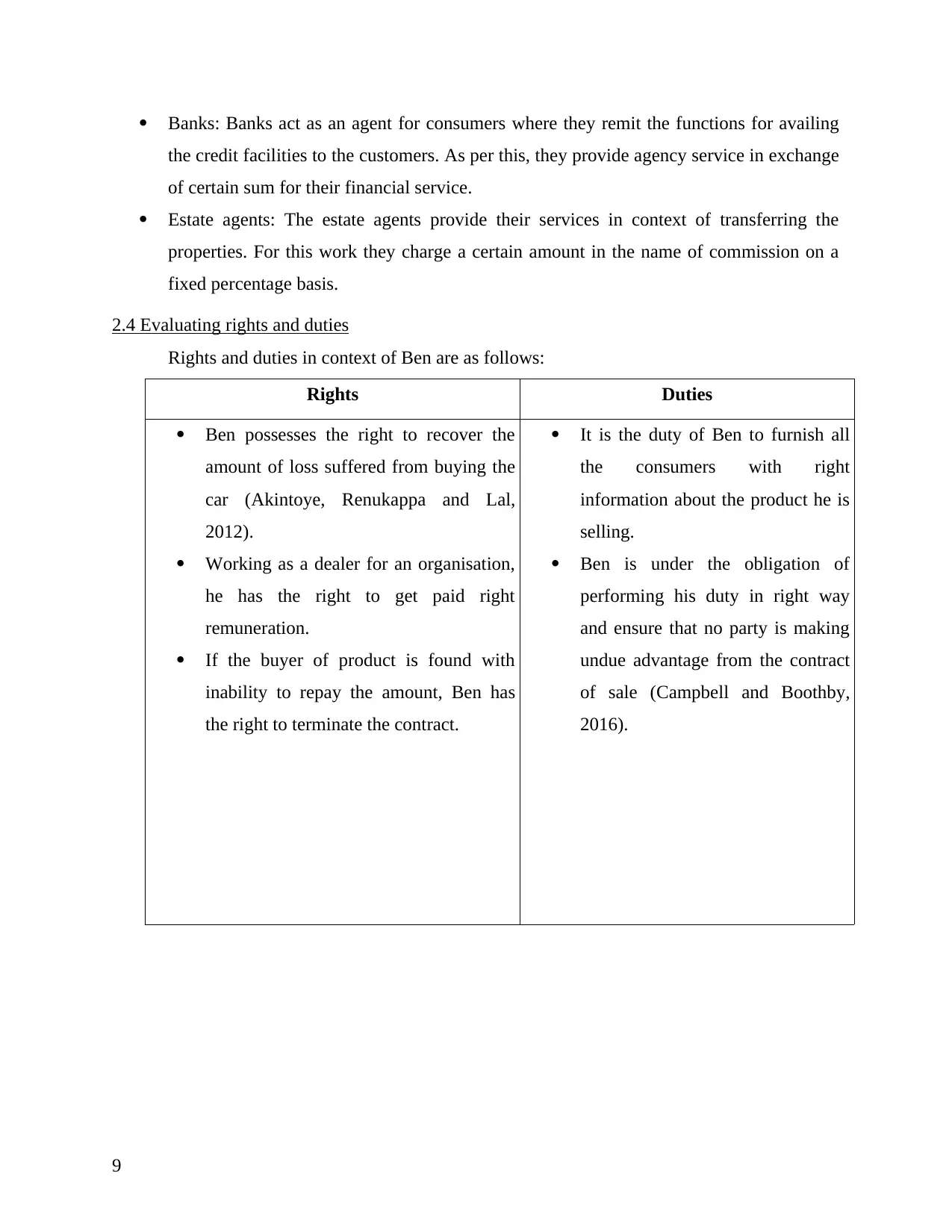
Banks: Banks act as an agent for consumers where they remit the functions for availing
the credit facilities to the customers. As per this, they provide agency service in exchange
of certain sum for their financial service.
Estate agents: The estate agents provide their services in context of transferring the
properties. For this work they charge a certain amount in the name of commission on a
fixed percentage basis.
2.4 Evaluating rights and duties
Rights and duties in context of Ben are as follows:
Rights Duties
Ben possesses the right to recover the
amount of loss suffered from buying the
car (Akintoye, Renukappa and Lal,
2012).
Working as a dealer for an organisation,
he has the right to get paid right
remuneration.
If the buyer of product is found with
inability to repay the amount, Ben has
the right to terminate the contract.
It is the duty of Ben to furnish all
the consumers with right
information about the product he is
selling.
Ben is under the obligation of
performing his duty in right way
and ensure that no party is making
undue advantage from the contract
of sale (Campbell and Boothby,
2016).
9
the credit facilities to the customers. As per this, they provide agency service in exchange
of certain sum for their financial service.
Estate agents: The estate agents provide their services in context of transferring the
properties. For this work they charge a certain amount in the name of commission on a
fixed percentage basis.
2.4 Evaluating rights and duties
Rights and duties in context of Ben are as follows:
Rights Duties
Ben possesses the right to recover the
amount of loss suffered from buying the
car (Akintoye, Renukappa and Lal,
2012).
Working as a dealer for an organisation,
he has the right to get paid right
remuneration.
If the buyer of product is found with
inability to repay the amount, Ben has
the right to terminate the contract.
It is the duty of Ben to furnish all
the consumers with right
information about the product he is
selling.
Ben is under the obligation of
performing his duty in right way
and ensure that no party is making
undue advantage from the contract
of sale (Campbell and Boothby,
2016).
9
⊘ This is a preview!⊘
Do you want full access?
Subscribe today to unlock all pages.

Trusted by 1+ million students worldwide
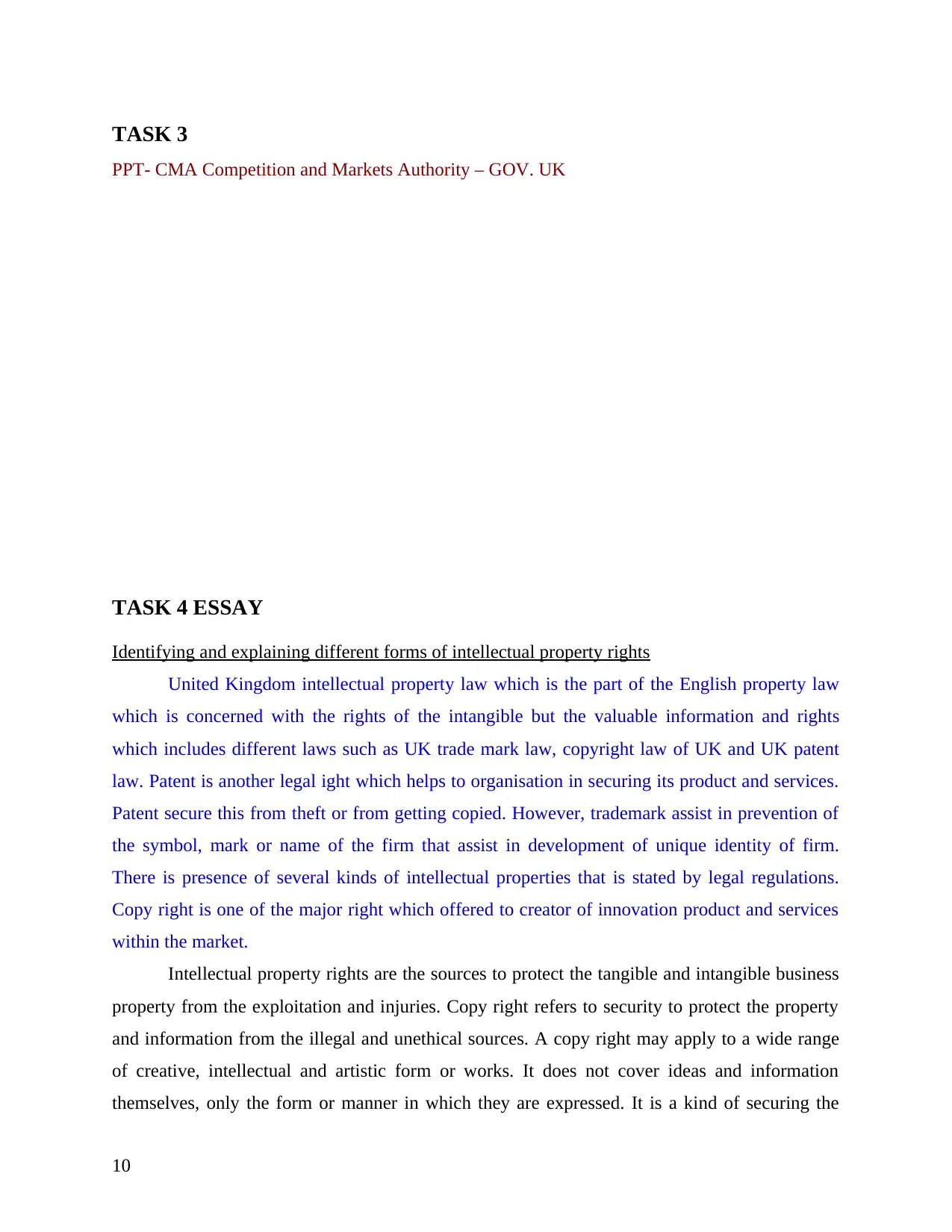
TASK 3
PPT- CMA Competition and Markets Authority – GOV. UK
TASK 4 ESSAY
Identifying and explaining different forms of intellectual property rights
United Kingdom intellectual property law which is the part of the English property law
which is concerned with the rights of the intangible but the valuable information and rights
which includes different laws such as UK trade mark law, copyright law of UK and UK patent
law. Patent is another legal ight which helps to organisation in securing its product and services.
Patent secure this from theft or from getting copied. However, trademark assist in prevention of
the symbol, mark or name of the firm that assist in development of unique identity of firm.
There is presence of several kinds of intellectual properties that is stated by legal regulations.
Copy right is one of the major right which offered to creator of innovation product and services
within the market.
Intellectual property rights are the sources to protect the tangible and intangible business
property from the exploitation and injuries. Copy right refers to security to protect the property
and information from the illegal and unethical sources. A copy right may apply to a wide range
of creative, intellectual and artistic form or works. It does not cover ideas and information
themselves, only the form or manner in which they are expressed. It is a kind of securing the
10
PPT- CMA Competition and Markets Authority – GOV. UK
TASK 4 ESSAY
Identifying and explaining different forms of intellectual property rights
United Kingdom intellectual property law which is the part of the English property law
which is concerned with the rights of the intangible but the valuable information and rights
which includes different laws such as UK trade mark law, copyright law of UK and UK patent
law. Patent is another legal ight which helps to organisation in securing its product and services.
Patent secure this from theft or from getting copied. However, trademark assist in prevention of
the symbol, mark or name of the firm that assist in development of unique identity of firm.
There is presence of several kinds of intellectual properties that is stated by legal regulations.
Copy right is one of the major right which offered to creator of innovation product and services
within the market.
Intellectual property rights are the sources to protect the tangible and intangible business
property from the exploitation and injuries. Copy right refers to security to protect the property
and information from the illegal and unethical sources. A copy right may apply to a wide range
of creative, intellectual and artistic form or works. It does not cover ideas and information
themselves, only the form or manner in which they are expressed. It is a kind of securing the
10
Paraphrase This Document
Need a fresh take? Get an instant paraphrase of this document with our AI Paraphraser
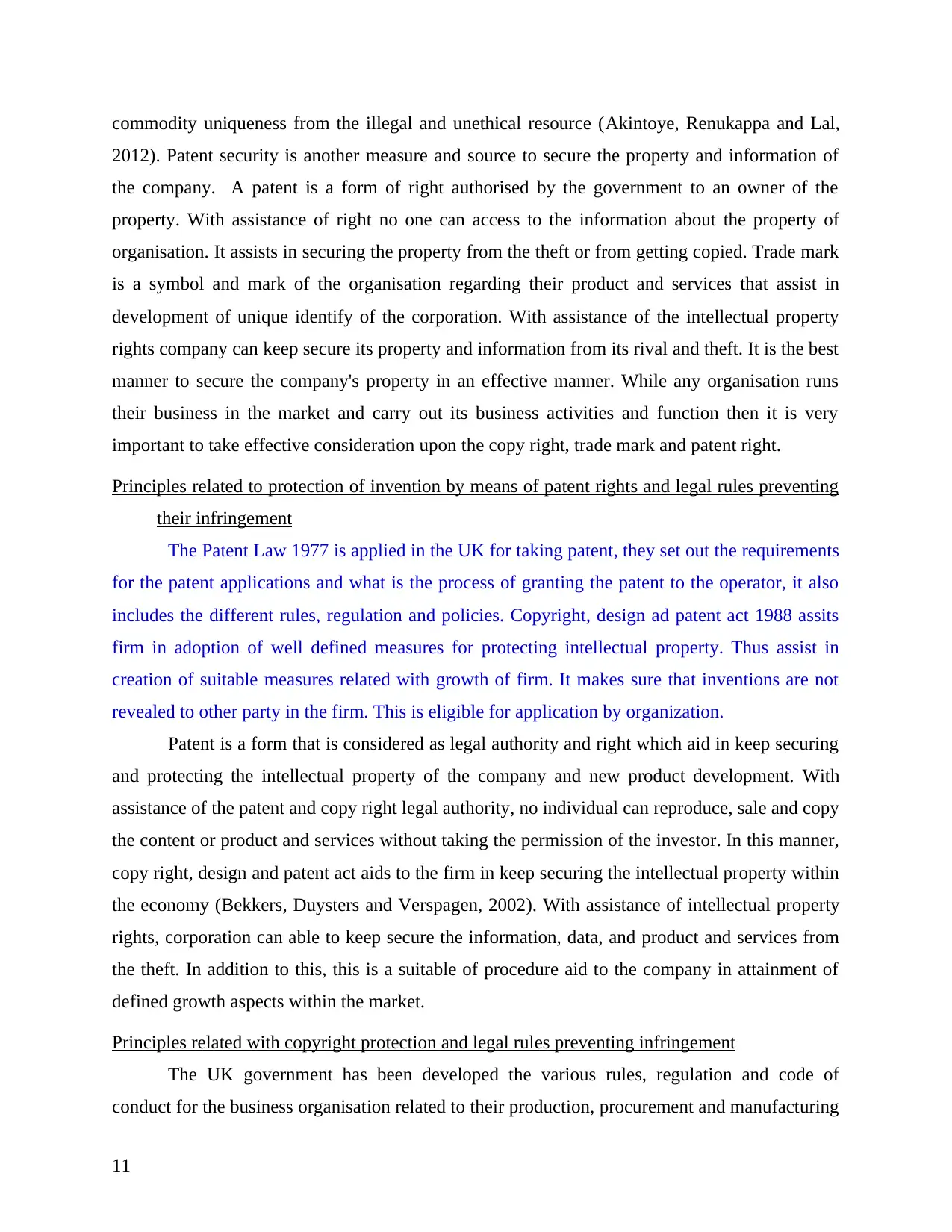
commodity uniqueness from the illegal and unethical resource (Akintoye, Renukappa and Lal,
2012). Patent security is another measure and source to secure the property and information of
the company. A patent is a form of right authorised by the government to an owner of the
property. With assistance of right no one can access to the information about the property of
organisation. It assists in securing the property from the theft or from getting copied. Trade mark
is a symbol and mark of the organisation regarding their product and services that assist in
development of unique identify of the corporation. With assistance of the intellectual property
rights company can keep secure its property and information from its rival and theft. It is the best
manner to secure the company's property in an effective manner. While any organisation runs
their business in the market and carry out its business activities and function then it is very
important to take effective consideration upon the copy right, trade mark and patent right.
Principles related to protection of invention by means of patent rights and legal rules preventing
their infringement
The Patent Law 1977 is applied in the UK for taking patent, they set out the requirements
for the patent applications and what is the process of granting the patent to the operator, it also
includes the different rules, regulation and policies. Copyright, design ad patent act 1988 assits
firm in adoption of well defined measures for protecting intellectual property. Thus assist in
creation of suitable measures related with growth of firm. It makes sure that inventions are not
revealed to other party in the firm. This is eligible for application by organization.
Patent is a form that is considered as legal authority and right which aid in keep securing
and protecting the intellectual property of the company and new product development. With
assistance of the patent and copy right legal authority, no individual can reproduce, sale and copy
the content or product and services without taking the permission of the investor. In this manner,
copy right, design and patent act aids to the firm in keep securing the intellectual property within
the economy (Bekkers, Duysters and Verspagen, 2002). With assistance of intellectual property
rights, corporation can able to keep secure the information, data, and product and services from
the theft. In addition to this, this is a suitable of procedure aid to the company in attainment of
defined growth aspects within the market.
Principles related with copyright protection and legal rules preventing infringement
The UK government has been developed the various rules, regulation and code of
conduct for the business organisation related to their production, procurement and manufacturing
11
2012). Patent security is another measure and source to secure the property and information of
the company. A patent is a form of right authorised by the government to an owner of the
property. With assistance of right no one can access to the information about the property of
organisation. It assists in securing the property from the theft or from getting copied. Trade mark
is a symbol and mark of the organisation regarding their product and services that assist in
development of unique identify of the corporation. With assistance of the intellectual property
rights company can keep secure its property and information from its rival and theft. It is the best
manner to secure the company's property in an effective manner. While any organisation runs
their business in the market and carry out its business activities and function then it is very
important to take effective consideration upon the copy right, trade mark and patent right.
Principles related to protection of invention by means of patent rights and legal rules preventing
their infringement
The Patent Law 1977 is applied in the UK for taking patent, they set out the requirements
for the patent applications and what is the process of granting the patent to the operator, it also
includes the different rules, regulation and policies. Copyright, design ad patent act 1988 assits
firm in adoption of well defined measures for protecting intellectual property. Thus assist in
creation of suitable measures related with growth of firm. It makes sure that inventions are not
revealed to other party in the firm. This is eligible for application by organization.
Patent is a form that is considered as legal authority and right which aid in keep securing
and protecting the intellectual property of the company and new product development. With
assistance of the patent and copy right legal authority, no individual can reproduce, sale and copy
the content or product and services without taking the permission of the investor. In this manner,
copy right, design and patent act aids to the firm in keep securing the intellectual property within
the economy (Bekkers, Duysters and Verspagen, 2002). With assistance of intellectual property
rights, corporation can able to keep secure the information, data, and product and services from
the theft. In addition to this, this is a suitable of procedure aid to the company in attainment of
defined growth aspects within the market.
Principles related with copyright protection and legal rules preventing infringement
The UK government has been developed the various rules, regulation and code of
conduct for the business organisation related to their production, procurement and manufacturing
11
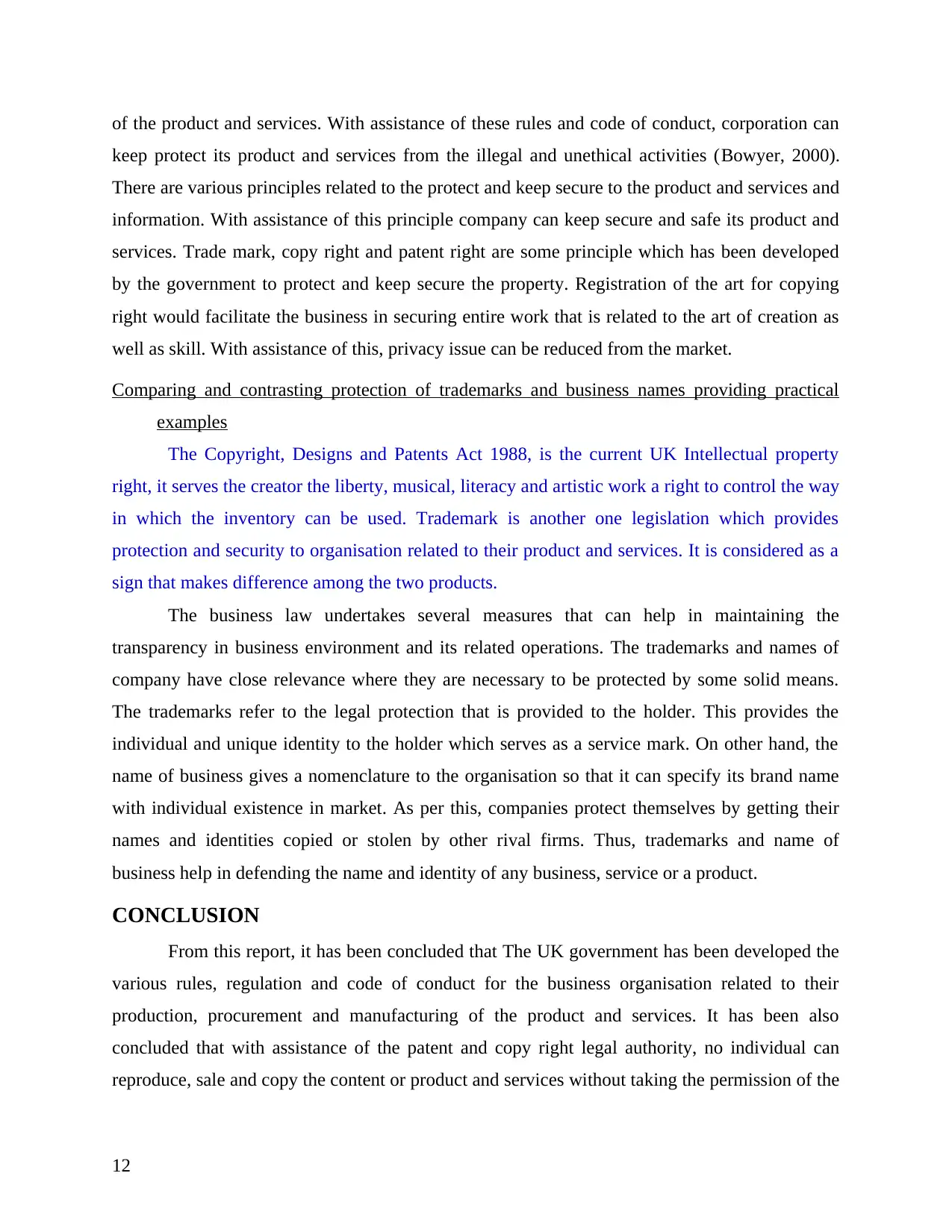
of the product and services. With assistance of these rules and code of conduct, corporation can
keep protect its product and services from the illegal and unethical activities (Bowyer, 2000).
There are various principles related to the protect and keep secure to the product and services and
information. With assistance of this principle company can keep secure and safe its product and
services. Trade mark, copy right and patent right are some principle which has been developed
by the government to protect and keep secure the property. Registration of the art for copying
right would facilitate the business in securing entire work that is related to the art of creation as
well as skill. With assistance of this, privacy issue can be reduced from the market.
Comparing and contrasting protection of trademarks and business names providing practical
examples
The Copyright, Designs and Patents Act 1988, is the current UK Intellectual property
right, it serves the creator the liberty, musical, literacy and artistic work a right to control the way
in which the inventory can be used. Trademark is another one legislation which provides
protection and security to organisation related to their product and services. It is considered as a
sign that makes difference among the two products.
The business law undertakes several measures that can help in maintaining the
transparency in business environment and its related operations. The trademarks and names of
company have close relevance where they are necessary to be protected by some solid means.
The trademarks refer to the legal protection that is provided to the holder. This provides the
individual and unique identity to the holder which serves as a service mark. On other hand, the
name of business gives a nomenclature to the organisation so that it can specify its brand name
with individual existence in market. As per this, companies protect themselves by getting their
names and identities copied or stolen by other rival firms. Thus, trademarks and name of
business help in defending the name and identity of any business, service or a product.
CONCLUSION
From this report, it has been concluded that The UK government has been developed the
various rules, regulation and code of conduct for the business organisation related to their
production, procurement and manufacturing of the product and services. It has been also
concluded that with assistance of the patent and copy right legal authority, no individual can
reproduce, sale and copy the content or product and services without taking the permission of the
12
keep protect its product and services from the illegal and unethical activities (Bowyer, 2000).
There are various principles related to the protect and keep secure to the product and services and
information. With assistance of this principle company can keep secure and safe its product and
services. Trade mark, copy right and patent right are some principle which has been developed
by the government to protect and keep secure the property. Registration of the art for copying
right would facilitate the business in securing entire work that is related to the art of creation as
well as skill. With assistance of this, privacy issue can be reduced from the market.
Comparing and contrasting protection of trademarks and business names providing practical
examples
The Copyright, Designs and Patents Act 1988, is the current UK Intellectual property
right, it serves the creator the liberty, musical, literacy and artistic work a right to control the way
in which the inventory can be used. Trademark is another one legislation which provides
protection and security to organisation related to their product and services. It is considered as a
sign that makes difference among the two products.
The business law undertakes several measures that can help in maintaining the
transparency in business environment and its related operations. The trademarks and names of
company have close relevance where they are necessary to be protected by some solid means.
The trademarks refer to the legal protection that is provided to the holder. This provides the
individual and unique identity to the holder which serves as a service mark. On other hand, the
name of business gives a nomenclature to the organisation so that it can specify its brand name
with individual existence in market. As per this, companies protect themselves by getting their
names and identities copied or stolen by other rival firms. Thus, trademarks and name of
business help in defending the name and identity of any business, service or a product.
CONCLUSION
From this report, it has been concluded that The UK government has been developed the
various rules, regulation and code of conduct for the business organisation related to their
production, procurement and manufacturing of the product and services. It has been also
concluded that with assistance of the patent and copy right legal authority, no individual can
reproduce, sale and copy the content or product and services without taking the permission of the
12
⊘ This is a preview!⊘
Do you want full access?
Subscribe today to unlock all pages.

Trusted by 1+ million students worldwide
1 out of 14
Related Documents
Your All-in-One AI-Powered Toolkit for Academic Success.
+13062052269
info@desklib.com
Available 24*7 on WhatsApp / Email
![[object Object]](/_next/static/media/star-bottom.7253800d.svg)
Unlock your academic potential
Copyright © 2020–2025 A2Z Services. All Rights Reserved. Developed and managed by ZUCOL.




